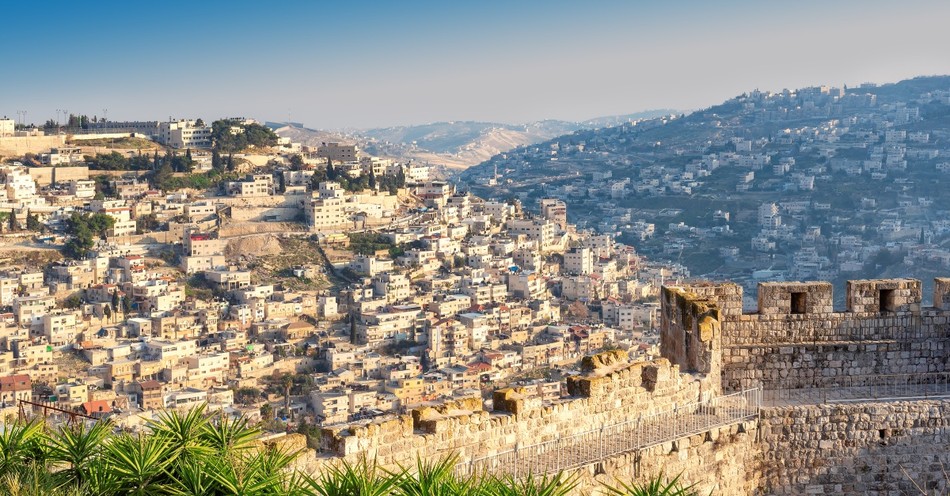Jesus stood on a mountain and declared, “A city on a hill cannot be hidden.” Christ taught this as part of the famous Sermon on the Mount, and Christians have referred back to the epic imagery of a “city on a hill” over the centuries for various purposes.
Through this statement and others, Jesus meant to communicate an important concept to his followers. Looking at the context and what those words would have meant to the audience will reveal truths for us today.
Where Does the Phrase “City on a Hill” Come From?
As part of Jesus’ Sermon on the Mount, Matthew 5:14 says, “You are the light of the world. A city set on a hill cannot be hidden.” The whole sermon teaches Christ’s disciples about the culture of the Kingdom of Heaven and how his followers should live in the world.
In Matthew 5:13-16, Jesus reveals how his disciples play an important role in society. “You are the salt of the earth.” Salt, in the ancient world, symbolized life. It preserved food and added flavor, all relating to how Christians should have a positive and saving impact. But if salt loses its flavor, it becomes useless, Jesus says, communicating to his followers how losing their distinctiveness or spiritual influence leads to meaninglessness.
Along with salt, Jesus calls his disciples the “light of the world,” also explaining how light is meant to be seen, not hidden. Without light, people live and move in darkness. A lamp shouldn’t be placed under a basket (a ridiculous notion) but placed on a stand to give light to all. The Bible speaks about such distinctions as light and dark, absolute opposites, to express the difference between living with God and resisting him.
In the same way, a city on a hill sits in plain view. No one can hide that city because of its high position. This metaphor points to how Christians should be visibly different from the world around them, marked by their good deeds and reflecting God’s truth and love. Jesus concludes this section by saying, “Let your light shine before others, that they may see your good deeds and glorify your Father in heaven.” His teaching calls believers to be a transformative and hopeful presence in the world, living in such a way so others will be drawn to the light of Christ.
What is the Meaning of “City on a Hill”?
When Jesus referred to his disciples as a “city on a hill,” he used a powerful image with both historical and spiritual meaning.
Jerusalem, historically and spiritually, was seen as a city set apart for God. In the Old Testament, the Jebusite city of Jerusalem was famous for being “unconquerable” due to its elevation and defenses. Yet, David conquered the city and established it as the new capital. He brought the Ark of the Covenant there, and his son, Solomon, built the new Temple in the city. Jerusalem became the central Israelite city for spiritual, political, and cultural life as a beacon for the nations. Isaiah 62:7 talks of Jerusalem being established as a “praise on the earth,” pointing to God’s intention for Jerusalem to shine bright among the nations. God often saved Jerusalem for its symbolism of God’s presence and glory, and it was the last city God gave over to foreign power due to its idolatry. When Jesus referred to a “city on a hill,” the audience likely thought of Jerusalem for these reasons.
In Jesus’ time, Jerusalem had lost some of its spiritual strength, and his message reminded his disciples how they, as a community of people, were to be the true light in the world. Jesus called them to live in such a way as to restore the visibility of faith, showing God’s goodness through their lives. Such a community transcends a place, even Jerusalem.
When God sent the Spirit to his disciples (Acts 2), it happened in Jerusalem, and the early church lived Christ’s teachings there in Jerusalem. Their healing and generosity became known throughout the region. People knew they could travel to Christ’s followers in Jerusalem to get healed of sickness and disease (Acts 5:16). They lived as a city upon a hill through the Spirit.
This “city on a hill” also points to the eternal new heaven and earth. In Revelation 21:2, the apostle John describes the New Jerusalem coming down out of heaven, prepared as a bride for Christ. The New Jerusalem symbolizes the people of God, the Church, radiant with God’s glory and presence. In John’s vision, the city isn’t only a physical location but the collective body of believers. The final description of the New Jerusalem as a radiant, holy city reveals the present heavenly reality and the ultimate fulfillment of Jesus’ teaching in Matthew 5:14. His followers are a shining city, revealing God’s kingdom on earth.
How Does Being a “City on a Hill” Relate to Christian Witness?
God delivered Israel from Egyptian slavery and called them to the Promised Land to be an outpost of heaven on earth, to live in such a way that other peoples would recognize the blessing of living under God’s rule and reign. Jerusalem, by extension and with Solomon’s Temple, became a focal point of that mission. The Israelites lost this privilege through their disobedience and idolatry. Yet Christ came to bring all people into this purpose if they would believe in Him.
Christians, saved and filled with the Holy Spirit, gather as the family of God and become an even greater outpost of the Kingdom of God. Believers together show the world what heaven on earth looks like. God calls disciples to live out the Gospel through love, unity, and demonstrating God’s glory. No Christian can be a “city on a hill” alone. It’s meant to be lived “where two or more are gathered in my name.” (Matthew 18:20)
Upon repentance to the Father, believers are saved by grace through faith in Jesus Christ. Salvation transforms us from the inside out, and God renews and empowers us with the Holy Spirit, who alone gives us the ability to live in obedience to God. The Spirit works within us to bear fruit of love, joy, peace, patience, kindness, goodness, faithfulness, gentleness, and self-control (Galatians 5:22-23). God designed this transformation to be shared like a lamp or a city on a hill.
And yet, alone, a believer can’t express God. God is within himself a community and family, three in one, the mystery of the Trinity. To be the light of the world, Jesus' followers must also live as the family of God and exemplify the Kingdom of Heaven. The way they live—actions, attitudes, and relationships—reveal what eternal life with God looks like. Jesus teaches how love and unity primarily mark true discipleship. “By this everyone will know that you are my disciples, if you love one another.” (John 13:35) Our love for one another preaches the Gospel to the lost and broken, declaring and showing that the Kingdom of Heaven is real.
As the “city on a hill,” the Christian community lives as a beacon of hope, shining God’s light through our love, unity, and Spirit-filled lives.
What is the Historical Context of How Christians Have Applied This Verse?
After Pentecost, Christians sought to create communities that exemplified the teachings of Christ, especially separate from the surrounding pagan and Roman culture. The early Christians were known for their love, unity, and care for the poor and sick, which marked them as different. The city on a hill defined their mission, to be a light to the world by living radically, rooted in Jesus’ teachings. As such, God added to their number daily (Acts 2:47).
Centuries later, in the Puritan tradition, particularly with John Winthrop’s 1630 sermon “A Model of Christian Charity,” the phrase took on a role in shaping American colonial identity. Winthrop, leading a group of Puritans to the New World, used this verse to describe their new colony as a model Christian society. Seeing this new land as a way to separate themselves from the corrupt European politics and religion, Winthrop urged settlers to live in a way that would be an example to the world, showing how a “city on a hill” was possible. He hoped to inspire others through a community living in unity and love. However, many today realize the dangers of unifying the political and religious realms in the world, ultimately leading to more oppression than inspiration.
Throughout history, various Christian movements and leaders have used this verse to emphasize the moral responsibility that comes with being a visible church. The city on a hill has been a rallying cry for Christians to live out their faith publicly, advocating for various forms of justice and mercy. For example, the abolitionist movements in the 1800s, led by people like William Wilberforce and Harriet Beecher Stowe, advocated for the end of slavery, showing how Christian principles can drive social reform.
How Can Christians Today Live as a “City on a Hill”?
To begin with, we must focus on serving in and with the local church. Living as a city on a hill happens within faith communities, and we should foster love and unity within our churches. As Jesus declared in John 13:35, our love for one another is one of the most powerful testimonies of the Gospel’s transformative power. The church can reveal what the modern world seeks—unity and diversity. Without God, unity and diversity is impossible. Yet with him, all people, regardless of age, background, culture, or nationality, become one through the Spirit. This means actively building unity across cultural, racial, and generational lines within the Church. When we live in unity despite natural differences, we show the world the supernatural reconciliation and peace Jesus brings. Love within our faith communities should be tangible, where we support, encourage, and pray for each other.
Living as a “city on a hill” involves a further commitment to generosity, especially with the broken and marginalized. The Apostle James tells us how our true religion is to care for orphans and widows (James 1:27), representing vulnerable and marginalized communities. Find ways as a church or small group to serve local communities: feeding the hungry, helping the homeless, and advocating for justice for the oppressed. By coming together to meet the practical needs of hurting people, we reveal God’s heart for the poor and his redeeming love.
Side by side with outward generosity, we should speak truth and declare the Gospel. Faith comes by hearing the word of God, and the Gospel must be shared through a vocal message of salvation through Christ alone (Romans 10:14). We can declare the one Gospel through various creative ways: art, technology, social media, and personal testimonies. Just as David sang new songs, we can find new ways to communicate the timeless Gospel, meeting people where they are in relatable, engaging avenues, shining bright as beacons of hope.
Peace.
Photo credit: ©Getty/lucky-photographer





.jpg)